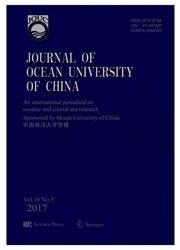

 中文摘要:
中文摘要:
Harmful algal blooms(HABs) have led to extensive ecological and environmental issues and huge economic losses.Various HAB control techniques have been developed,and biological methods have been paid more attention.Algicidal bacteria is a general designation for bacteria which inhibit algal growth in a direct or indirect manner,and kill or damage the algal cells.A metabolite which is strongly toxic to the dinoflagellate Alexandrium tamarense was produced by strain DH46 of the alga-lysing bacterium Alteromonas sp.The culture conditions were optimized using a single-factor test method.Factors including carbon source,nitrogen source,temperature,initial pH value,rotational speed and salinity were studied.The results showed that the cultivation of the bacteria at 28℃ and 180 r min-1with initial pH 7 and 30 salt contcentration favored both the cell growth and the lysing effect of strain DH46.The optimal medium composition for strain DH46 was determined by means of uniform design experimentation,and the most important components influencing the cell density were tryptone,yeast extract,soluble starch,NaNO3 and MgSO4.When the following culture medium was used(tryptone 14.0g,yeast extract 1.63g,soluble starch 5.0 g,NaNO3 1.6 g,MgSO4 2.3 g in 1L),the largest bacterial dry weight(7.36 g L-1) was obtained,which was an enhancement of 107% compared to the initial medium;and the algal lysis rate was as high as 98.4% which increased nearly 10% after optimization.
 英文摘要:
英文摘要:
Harmful algal blooms (HABs) have led to extensive ecological and environmental issues and huge economic losses. Various HAB control techniques have been developed, and biological methods have been paid more attention. Algicidal bacteria is a general designation for bacteria which inhibit algal growth in a direct or indirect manner, and kill or damage the algal cells. A me- tabolite which is strongly toxic to the dinoflagellate Alexandrium tamarense was produced by strain DH46 of the alga-lysing bacte- rium Alteromonas sp. The culture conditions were optimized using a single-factor test method. Factors including carbon source, ni- trogen source, temperature, initial pH value, rotational speed and salinity were studied. The results showed that the cultivation of the bacteria at 28℃ and 180rmin^-1 with initial pH 7 and 30 salt contcentration favored both the cell growth and the lysing effect of strain DH46. The optimal medium composition for strain DH46 was determined by means of uniform design experimentation, and the most important components influencing the cell density were tryptone, yeast extract, soluble starch, NaNO3 and MgSO4. When the following culture medium was used (tryptone 14.0g, yeast extract 1.63g, soluble starch 5.0 g, NaNO31.6 g, MgSO4 2.3 g in 1L), the largest bacterial dry weight (7.36gL^-1) was obtained, which was an enhancement of 107% compared to the initial medium; and the algal lysis rate was as high as 98.4% which increased nearly 10% after optimization.
 同期刊论文项目
同期刊论文项目
 同项目期刊论文
同项目期刊论文
 A novel algae-lysing microorganism that inhibits the growth of Phaeodactylum tricornutum and other a
A novel algae-lysing microorganism that inhibits the growth of Phaeodactylum tricornutum and other a Mangrovimonas yunxiaonensis gen. nov. sp. nov., isolated from Yunxiao mangrove sediment, Fujian prov
Mangrovimonas yunxiaonensis gen. nov. sp. nov., isolated from Yunxiao mangrove sediment, Fujian prov Virus infection disturbs cyclin expression, leading to cell cycle arrest in the unicellular marine a
Virus infection disturbs cyclin expression, leading to cell cycle arrest in the unicellular marine a Phaeocystidibacter luteus gen. nov., sp nov., a member of the family Cryomorphaceae isolated from th
Phaeocystidibacter luteus gen. nov., sp nov., a member of the family Cryomorphaceae isolated from th Bacterial community dynamics during a bloom caused by Akashiwo sanguinea in the Xiamen Sea Area, Chi
Bacterial community dynamics during a bloom caused by Akashiwo sanguinea in the Xiamen Sea Area, Chi Imperialibacter roseus gen. nov., sp. nov., a novel bacterium of the family Flammeovirgaceae isolate
Imperialibacter roseus gen. nov., sp. nov., a novel bacterium of the family Flammeovirgaceae isolate Diversity and abundance of anammox bacterial community in the deep-ocean surface sediment from equat
Diversity and abundance of anammox bacterial community in the deep-ocean surface sediment from equat Effect of Oxidative Stress Induced by Brevibacterium sp BS01 on a HAB Causing Species-Alexandrium ta
Effect of Oxidative Stress Induced by Brevibacterium sp BS01 on a HAB Causing Species-Alexandrium ta Novel Bacterial Isolate from Permian Groundwater, Capable of Aggregating Potential Biofuel-Producing
Novel Bacterial Isolate from Permian Groundwater, Capable of Aggregating Potential Biofuel-Producing Culture-independent and-dependent methods to investigate the diversity of planktonic bacteria in the
Culture-independent and-dependent methods to investigate the diversity of planktonic bacteria in the Optimization of culture conditions and medium composition for the marine algicidal bacterium Alterom
Optimization of culture conditions and medium composition for the marine algicidal bacterium Alterom A marine algicidal actinomycete and its active substance against the harmful algal bloom species Pha
A marine algicidal actinomycete and its active substance against the harmful algal bloom species Pha 期刊信息
期刊信息
